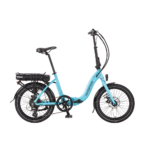Does anyone know what the relationship is between amps drawn by my BBS01B controller, and motor power? Presently, my controller is set to 15A - this adequate for all the tasks I've asked of my 20" wheeled folding bike so far, including hauling heavy bike trailers up steep hills, for much of the summer. However, I am unclear as to how much motor power I can expect, if I set my controller to 20A. Below is a graph of my new prospective PAS settings - I didn't want a completely straight line to 20A. I wanted a straight-ish line to 15A, because I know my battery and controller cope fine with 15A. The progression from 15A to 20A is cautious, in case something goes up in flames or explodes. Levels 5 to 9 would only be used in exceptional circumstances, as would level "0", which at 1.2A, as far as I can discern, is the minimum required to overcome motor resistance, plus a bit. At the moment, I almost never use less than 15A, unless running low on battery (19.2ah with LG MH1 cells, 22A BMS).
Edit: it's a 36V battery.

Edit: it's a 36V battery.

Last edited:








